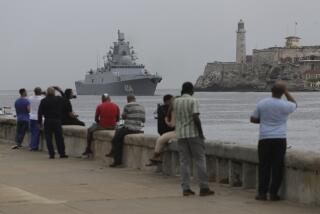Many Barriers Could Impede Rescue of Sub, Experts Say
SAN DIEGO — U.S. Navy submarine rescue experts said Tuesday that Russian efforts to free sailors from a crippled sub at the bottom of the Barents Sea face daunting obstacles, any one of which could spell failure for a maneuver that, even under ideal conditions, is difficult and dangerous.
The major problem would be if the angle at which the submarine Kursk lay on the sea floor was too sharp to enable the hatches of the sub and the rescue craft to “mate” so the submariners could scramble to safety.
“If the angle is much more than 45 degrees, it’s like trying to land an airplane on a wall,” said retired Navy Capt. Don Walsh, a former submarine commander and onetime head of the Navy’s undersea research and technology division.
If the angle is surmountable, the rescue effort could still be thwarted if the hatch was damaged or led to a compartment that had been flooded.
Inexperience on the part of the Russian personnel handling the rescue vehicle also could hamper efforts.
And there is the grim possibility that the rescue effort, which is slow and laborious in part because of the limited capability of Russian rescue technology, will be too late to save any of the Kursk’s 116 crew members.
“It must be terribly stressful for the Russian personnel, trying to save those young sailors and also worrying about how this tragedy will be a national embarrassment,” said retired Navy Vice Adm. Bernard Kauderer, who commanded the U.S. submarine fleets in the Atlantic and Pacific.
Navy experts say that while the Russians have equipment to attempt a rescue, their ability to use the equipment appears untested.
“The Russians have assets, but how trained they are is another question,” said Walsh. “Training takes time and money, and the Russians haven’t had a lot of money recently.”
If the Russians succeed--and even their own admirals have said the chances are slim--it could be the first time in at least half a century that an undersea rescue of submariners has been successful.
The U.S. Navy has never had to employ the rescue technology it developed after the loss of two submarines, the Thresher in 1963 and the Scorpion in 1968. The Soviets reportedly tried a rescue in 1983 and failed.
The current effort has been hampered by the fact that the Russians are using a rescue craft that does not have the capability of the U.S. Navy’s Deep Submergence Rescue Vehicles, which are stationed at North Island Naval Air Station in San Diego and kept on 24-hour standby to be flown anywhere in the world where a U.S. submarine is imperiled.
A Russian navy spokesman said the rescue effort is using a bell-shaped capsule launched by a specially equipped surface ship. Rough weather in the Barents Sea frustrated rescue efforts Monday and Tuesday.
The U.S. Navy’s DSRVs are launched from “mother submarines,” and thus weather and sea conditions are not a bar to rescue efforts.
If a U.S. submarine, or that of another NATO country, had been stranded in a similar position off a friendly port, a DSRV--which is shaped like a mini-submarine--would probably have been in position to attempt a rescue within 24 hours, according to Walsh.
In addition, the Russian capsule does not have the technology to prevent rescued submariners from suffering the “bends” if they are brought to the surface too quickly. One estimate is that it will take up to seven hours for the capsule to surface, thus delaying return trips to reach additional sailors.
The DSRVs can move sailors quickly to the waiting “mother submarines,” where medical attention is ready. With a crew of four, a DSRV can carry as many as 24 rescued sailors.
The DSRVs are equipped with sonar and low-light cameras to find submarines in even the murkiest of water--a capability that the Russian capsule is thought to lack. The Barents Sea is inky, making discovery difficult.
Even if the Russians asked for U.S. assistance, it is unclear whether the hatches of the Russian submarine and the American rescue craft would be compatible in size and configuration. In the 1970s, when the U.S. was developing its rescue technology, an overture was made to the then-Soviet navy to standardize its hatches, but no response was received.
One reason the Soviets did not accept the U.S. offer might have been fear that compatible hatches would have made it easier for the U.S. Navy to recover a Soviet submarine and thus be able to gauge the Soviet Union’s state of readiness. While designed as rescue craft, the DSRVs also have been used for intelligence gathering.
As the Russians continued rescue efforts early today, their old adversaries, who once shadowed Soviet submarines in a Cold War undersea cat-and-mouse game, said they wished there was something they could do to help.
“Submariners everywhere are pulling for that captain to survive,” said Harry Mathis, a retired submarine captain who is now a San Diego City Council member. “It’s a very hostile environment, very dangerous, one that men weren’t designed to survive in.”
“It’s a race against time,” said Walsh. “It’s very desperate.”
More to Read
Sign up for Essential California
The most important California stories and recommendations in your inbox every morning.
You may occasionally receive promotional content from the Los Angeles Times.










